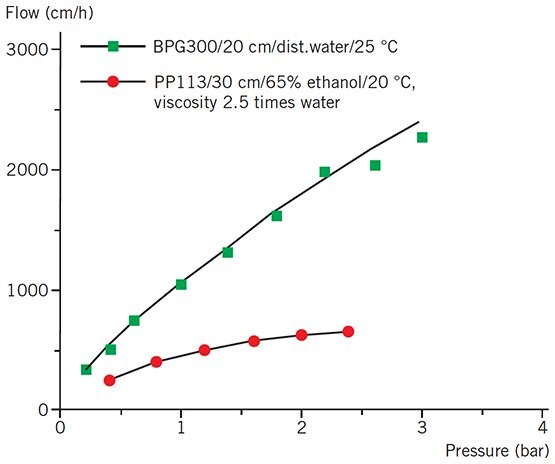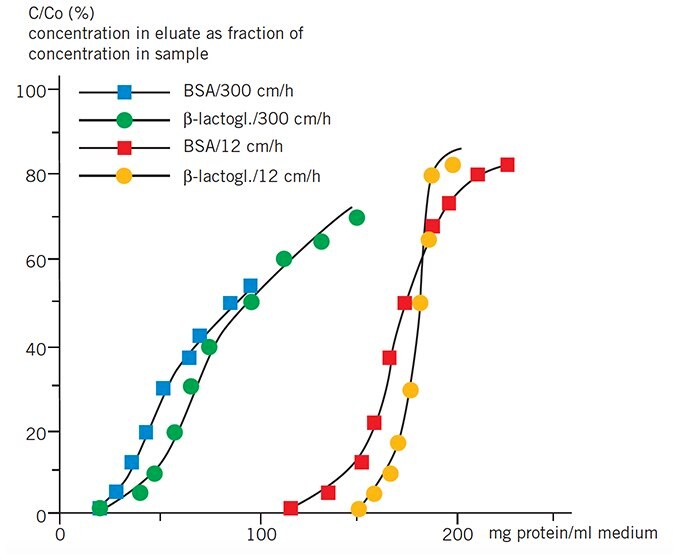Sepharose Big Beads: Purification from Crude, Viscous Samples at Large Scale
Use Sepharose Big Beads for purification of proteins from crude, viscous samples.
Use Sepharose Big Beads when handling large volumes of crude or viscous samples that must be bound rapidly and when resolution is less important.
Use Sepharose Big Beads for capture steps, when viscosity and back-pressure may limit the throughput attainable with ion exchangers of smaller particle size.
Run columns packed with Sepharose Big Beads on systems such as ÄKTAdesign, FPLC System and HPLC or systems using peristaltic pumps. Appendix 4 gives guidance on how to select the most suitable ÄKTAdesign system.
Sepharose Big Beads are ion exchangers designed for large-scale industrial applications. The media are based on 100–300 μM, cross-linked 6% agarose particles, substituted with quaternary ammonium (Q) or sulfopropyl (SP) groups. The large particle size, together with a high degree of cross-linking for extreme physical and chemical stability, ensures that high flow rates can be maintained when processing very viscous samples. For example, a flow of 500 cm/h can be maintained in an industrial process at viscosities up to 2.5 times the viscosity of water. More dilute samples can be run at 1000 cm/h. Particle size and bed volumes remain stable, despite changes in ionic strength or pH. The strong ion exchange groups (Q and SP) maintain their charge over a broad pH range, allowing selection of the most suitable pH for each application.
Figures 67 and 68 show the excellent flow characteristics and typical binding capacities for Big Bead media.

Figures 67. Sepharose Big Beads allow high flow rates with high viscosity samples.

Figures 68. Typical binding capacities of SP Sepharose Big Beads. Binding capacity measured in acetate pH 5 for bovine serum albumin and formate pH 4.1 for b-lactoglobulin at linear flows of 12 and 300 cm/h.
Purification options
*Appendix 5 to convert linear flow (cm/hour) to volumetric flow rates (mL/min) and vice versa.
**Working pH range refers to the pH interval where the medium binds protein as intended or as needed for elution without adverse long term effects.
***Maximum operating back pressure refers to the pressure above which the medium begins to compress.
For column packing during method development, particularly when handling crude, viscous samples:
Select a production scale column such as BPG or Chromaflow for larger volumes. Sepharose Big Beads can be packed in large scale columns by applying constant pressure between 1–3 bar, by slurry sedimentation followed by adaptor compression, or by suction packing. Follow the instructions supplied with the medium.
Performing a separation
Guidelines for selection of media, buffer, pH and ionic strength conditions and method optimization are given in Chapter 2. See Appendix 2 for recommendations on volatile and non-volatile buffer systems.
Correct sample and buffer preparation is essential in order to achieve optimal separation and avoid any deterioration in column performance. Refer to Chapter 2 and Appendix 1 for recommendations and advice.
Filter buffers after all salts and additives have been included. Use high quality water and chemicals. Filter solutions through 1 μM filters. To avoid formation of air bubbles in a packed column, maintain buffers and columns at a constant temperature before and during a run.
First time use or after long term storage
- Wash with 5 column volumes of distilled water at 300 cm/h.
- Wash with 5 column volumes of start buffer, same flow as step 1.
- Wash with 5 column volumes of elution buffer, same flow as step 1.
- Wash with 5 column volumes of start buffer, same flow as step 1.
- Run a blank elution before applying sample.
Gradient or step elution
Conditions for a large scale purification using Sepharose Big Beads will be determined during method development and relate to the specific application. Refer to Chapter 2 for advice on optimizing a separation. Typical separation flow rates should be 200–500 cm/h.
If ionic detergents have been used, wash the column with 5 column volumes of distilled water, followed by 2 column volumes 2 M NaCl. Re-equilibrate with at least 10 column volumes of start buffer until the UV baseline, eluent pH and/or conductivity are stable. Organic solvents such as ethanol can be used to remove non-ionic detergents. When selecting an organic solvent, check the chemical stability of the medium to determine a suitable concentration.
Check column performance regularly by determining column efficiency and peak symmetry.
See Appendix 3.
Cleaning
Correct preparation of samples and buffers and application of a high salt wash (1 M NaCl) at the end of each separation should keep most columns in good condition. However, reduced performance, a slow flow rate, increasing back pressure or complete blockage are all indications that the medium needs to be cleaned using more stringent procedures in order to remove contaminants.
It is recommended to reverse the direction of flow during column cleaning so that contaminants do not need to pass through the entire length of the column. The number of column volumes and time required for each cleaning step may vary according to the degree of contamination. If the cleaning procedure to remove common contaminants does not restore column performance, change the top filter (when possible) before trying alternative cleaning methods. Care should be taken when changing a filter as this may affect the column packing and interfere with performance.
The following procedure should be satisfactory to remove common contaminants
- Wash with at least 2 column volumes of 2 M NaCl at 40 cm/h for a contact time of 1–2 hours.
- Wash with at least 4 column volumes of 1 M NaOH (same flow as step 1).
- Wash with at least 2 column volumes of 2 M NaCl (same flow as step 1).
- Rinse with at least 2 column volumes of distilled water (same flow as step 1) until the UV-baseline and the eluent pH are stable.
- Wash with at least 4 column volumes of start buffer or storage buffer (same flow as step 1) until eluent pH and conductivity have reached the required values.
To remove precipitated proteins, lipids, hydrophobically bound proteins or lipoproteins, refer to Appendix 1.
Media characteristics
Composition: sulfopropyl (SP) or quaternary amino (Q) groups coupled to highly cross-linked 6% agarose via chemically stable ether bonds.
*Long term pH stability refers to the pH interval where the medium is stable over a long period of time without adverse side effects on the chromatography performance.
Short term pH stability refers to the pH interval for regeneration, cleaning-in-place and sanitization procedures.
All ranges are estimates based on the experience and knowledge within Cytiva.
Chemical stability
For daily use, Sepharose Big Beads media are stable in all common, aqueous buffers, 1 M NaOH, denaturing agents (8 M urea, 6 M guanidine hydrochloride), with additives such as non-ionic detergents, 70% ethanol, 1 M acetic acid, 30% acetonitrile and 30% isopropanol.
Sepharose Big Beads can be used with organic solvents such as dimethylsulfoxide, dimethylformamide, tetrahydrofuran, acetone, chloroform, dichloromethane, dichloroethane and dichloroethane/pyridine (50:50) as well as polar solvents and aqueous/organic isolutions. The water in the medium can be exchanged by the alternative solvent with very little effect on the pore size of the matrix.
Avoid cationic detergents with SP Sepharose Big Beads. Avoid anionic detergents with Q Sepharose Big Beads. Avoid oxidizing agents.
Storage
For column storage, wash with 2 column volumes of distilled water followed by 2 column volumes of 20% ethanol. Include 0.2 M sodium acetate in the storage solution for SP Sepharose Big Beads. For small scale columns, degas the ethanol/water mixture thoroughly, for large scale columns ensure that an air trap is included before the column. Add storage solution at a low flow rate, checking the back pressure as the column equilibrates. Alternatively, store at neutral pH in buffer containing 20% ethanol or in 0.01 M NaOH.
Store at room temperature or, for long periods, store at +4 °C to +8 °C. Ensure that the column is sealed well to avoid drying out. Store unused media at +4 °C to +30 °C in 20% ethanol. Do not freeze.
Materials
To continue reading please sign in or create an account.
Don't Have An Account?